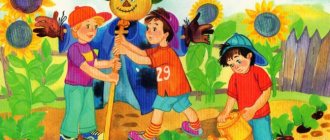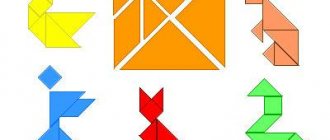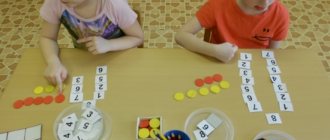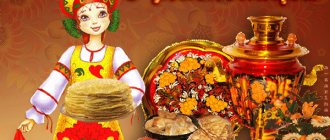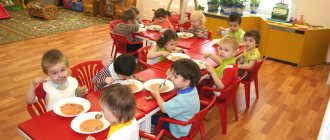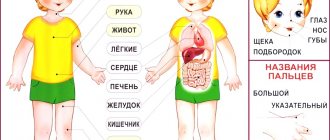Consultation for parents. Games with children “Cut-out pictures of the house and in the garden”
MUNICIPAL AUTONOMOUS EDUCATIONAL INSTITUTION
"Kindergarten No. 396", Perm
Consultation for parents of children of the second junior group
topic: “Cut pictures - at home and kindergarten”
Developed by teacher Yulia Vitalievna Fedeneva
Dear parents! An interesting option for didactic games are cut-out pictures, we’ll talk about this today. But first I want to ask you, do you use this game with your children and grandchildren? Where do you get the pictures? How do children behave in the game?
Cut picture
is a picture
cut
along straight lines into a different number of parts. The child does not have to think about the shape of the parts and can focus only on the image.
The purpose of cut pictures:
Teach your child to make a whole from several parts. In the process of playing with pictures, the child gets acquainted with the world around him, expands his vocabulary, activates speech, develops logical thinking and fine motor skills.
When a child collects a drawing, he must imagine what he is collecting, what image he will get. In this case, he must correlate the pieces with the image so that the correct place is allocated to it. Otherwise the illustration will not work. This requires concentration, seriousness, and attentiveness from children.
When folding cut images, the baby begins to realize the objective integrity and compose an illustration from parts. He trains his memory, develops thinking, and spatial orientation. Drawings are great for improving fine motor skills. By consolidating knowledge about objects and phenomena, assembling a whole from pieces, the goal of the cut-out pictures game is formed.
From simple to complex
At first it is better to use the simplest designs with a small number of individual pieces. The image should be familiar to the baby. A good option is two similar pictures, one of which is divided into 2 parts. In this case, one can be a sample.
After the child masters this fun, he will not need an example picture. For this game, drawings from coloring books or old books will be useful. It will be much more interesting if you draw them yourself. Use bright, but not irritating colors.
First, cut the images into two, then into three parts. Then increase the number of pieces gradually when the child folds the previous drawing on his own. You should know that the number of elements collected increases, and their size decreases. There are times when a baby puts together pictures with large pieces easier.
Very often in kindergarten I involve older children in making such games for younger children, and preschoolers are happy to help me. But at the same time, I am pursuing my goals, my task is not only to attract a child to artistic work, but also to teach how to cut paper, while developing children’s hands and fingers. The game of cut pictures is widely used in speech therapy activities with preschool children of the middle and senior groups. A speech therapist works with them and uses these games in his work. At every age, starting from 1.5 - 3 and continuing up to 7 years, the child is very interested in this fun, because with the help of it he learns the alphabet, toys, professions, transport, etc.
Methodology “Cut pictures”
The level of development of holistic perception of an object picture is investigated.
Stimulus material',
pictures cut into pieces with different cut configurations.
Standards.
cut-out picture of 2 fragments - 2.5-3 years;
cut-out picture of 3 fragments - 3-3.5 years;
cut picture of 3-5 fragments - 4-5 years;
cut picture of 5-8 fragments - 5-6 years
Progress of the study:
The child is asked to connect the disconnected parts of the picture to make a whole picture. Preview available.
Analysis of results:
 takes purposeful actions;
takes purposeful actions;
9) connects parts without analyzing the resulting whole;
10) application with a turn;
11) visual relationship of parts without application. Task completion levels:
• High level - completing the task by visual correlation. 1-2 practical tests are acceptable in the case of a 6-fragment picture.
• Intermediate level - completing a task through errors, application (3-6 fragments).
• Low level - composition with numerous inadequate samples or the picture does not add up.
Sensory level of action -
folds uncertainly, trying to pick up parts without focusing on any sign.
Perceptual level
- focuses on some sign of size, color, shape, but collects with errors.
Operational (mental) level of perceptual actions -
fast visual correlation. Features of children's mastery of various types of perception, the reasons for perception impairment are given in Appendices 3.4.1., 3.4.2.
Designing their sticks
The task is aimed at identifying the level of development of holistic perception, analysis of a sample, and the child’s ability to perform a task of imitation (2.5-3 years), a sample (from 4 years old), and from memory.
Stimulus material:
2-6 flat sticks of the same color.
Carrying out the examination:
In front of the child, they build a figure out of sticks (“hammer”, “mushroom”, “house”) and ask them to do the same: “Build it like mine.” If a child cannot complete a task by demonstration, he is asked to complete it by imitation: “Look and do as I do.” Then they are again asked to complete the task according to the model.
Children 4 years old perform the task only according to a ready-made model (in this case, the arrangement of the figures behind the screen changes, and the child is asked to reproduce) and from memory “Build again the house that you saw”).
Analysis of results:
1) imitation of the external manipulations of an adult without taking into account shape, size, spatial relationships (for 3-year-old children this is inadequate);
2) imitation of an adult’s manipulations, taking into account shape, spatial location, size;
3) comparison and correction of errors;
4) accurate reproduction of figures without errors or corrections;
5) independent sample analysis and reproduction.
Spatial Gnosis
The ability to navigate in space and distinguish spatial directions is studied. a) 2.5-4 years - showing objects in front, behind, above, below;
Stimulus material:
small toys and pictures placed in a box.
Example instructions:
“Put the bear near the box”, “Put it in the box”, “Put it on the box”, “Hide the picture under the box”, “Take it out from under the box”, “Show where the top (bottom)” is, “Go forward (back) "
Standards:
2.5 - 3 years - understands prepositional-case constructions; makes mistakes in 1-2 tasks, is easily corrected;
3.5-4 years - completes all tasks.
b) 4-6 years old - show objects that are on the right, left, above, below, in front, behind.
c) Speech version of the Head test.
1) Simple orientation (4-6 years).
Instructions: “Raise your left hand (you need to start only with your left hand^ show your right eye, left leg.” If the task is completed, then move on to the next one, if not, stop.
2) Instructions: “Grip your right ear with your left hand; with your right hand - behind your left ear; show your right eye with your left hand” (6 years old). Conclusions:
both tasks were completed (Head's tests); Only simple orientation was completed; not a single task was completed.
Performing the test is difficult in children with left hemisphere impairment and in children suffering from dyslexia.
Features of children's mastery of various types of perception, the reasons for perception impairment are given in Appendix 3.4.1 (Diagrams 1 and 2).
Coloring pages
To conduct classes on the topic “Toys” it is also very useful to use thematic coloring books. They help the child not only learn and remember all kinds of names of objects for games, but also practice using a large number of descriptive adjectives (in descriptions of various colors and materials). A correctly selected coloring book is a real helper for speech therapists and parents!
Pictures for the puzzle to print
To make a regular puzzle for children with your own hands, just take any picture and cut it into any number of pieces. But with shaped puzzles everything is more complicated.
How to use printable assignments
How to work with picture puzzles for children:
- print out the proposed puzzle picture, prepare scissors, and, if desired, a clean sheet of paper and glue;
- Explain the task to the child. That's it, the part for adults is over;
- then completely independent work : cut the puzzle along the contours;
- reassemble the puzzle in the correct order;
- stick on a blank sheet of paper as a finished applique.
Please note that some pictures specifically do not contain lines and patterns flowing from one puzzle element to another. This kind of puzzle is more difficult to assemble; you need to rely only on the shape of the elements, and to do this you need to cut the picture very carefully.
Drawn pictures
For the formation of a passive vocabulary, pictures for children depicting various toys are of great importance. It is very good if they are presented in a wide variety, this allows you to offer the child many different speech exercises and activities.
For speech therapy games, it is much more convenient to use cards rather than real objects. Sorting and describing images not only contributes to children’s speech development, but also improves them:
- visual-figurative thinking;
- RAM;
- attention.
Of course, it is very difficult to draw such pictures yourself; it is better to find ready-made ones selected by professional speech therapists.
